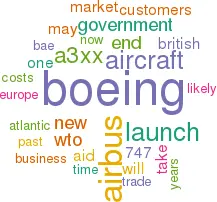Boeing, the A3XX and the WTO
May 2000


The announcement at the end of April by Emirates Airlines that it will buy up to 12 examples of the proposed Airbus A3XX makes it all the more likely that when the Airbus Industrie board meets on May 26 the much–delayed project will receive the go–ahead. The decision the meeting must take is whether to allow Airbus director general Noel Forgeard to make legally binding offers to airlines interested in being launch customers for the new range of aircraft. It would become available to launch customers at the end of 2005.
Sir Richard Branson, has already let it be known that Virgin Atlantic and its 49% shareholder, SIA, are interested in buying 16 A3XXs between them. Cathay Pacific and JAL are also likely launch customers. In addition, cargo carriers such as FedEx, Luxair and Atlas have expressed interest in the cargo variations of the new aircraft (unit operating savings of around 17% on the latest 747 are claimed).
British Airways, Lufthansa and Air France are clearly in less of a rush to sign up for the new aircraft. Nevertheless, they are understood to want to become "launch customers" on advantageous terms, while delaying their uptake of actual aircraft until 2007. With such a broad range of sup–port, Airbus can be expected to proceed with signing formal deals in time for a launch of production by the end of the year. One way or another, the Airbus decision is likely to be clarified at the Farnborough Air Show this July.
The lobbying message
Against this background Boeing is getting ready to launch a last–ditch attempt to prevent the A3XX going ahead. It has been busily updating its knowledge of European governments' industrial policies on support and subsidies which may be used to get the A3XX off the ground, at a cost of at least $12bn before the first example flies. Boeing is also planning a big announcement for this summer’s Farnborough, which could be its own product plans to update the 747 to frustrate the launch of the A3XX. For the past years or so Boeing marketing executives have been touring Europe lobbying prime ministers, legislators, airline executives and journalists with the message that this new Airbus project would be a disaster for the whole industry. Instead of a market for 1,200, they see sales of only 400 for such an aircraft. But this is pure spin: the Airbus estimate reasonably includes all aircraft above 400 seats, which means that its envisages eating into the market for the ageing 747, and even then getting only about half the total potential, because Boeing will find ways of stretching and updating their venerable jumbo, not least by cutting its price to improve its economics.
Rules governing government aid are enshrined in the Large Aircraft Agreement, a bilateral deal between the US and the EU signed in 1992. Broadly, this limits indirect aid to Boeing from the US government to 3% of turnover, while launch aid on the non–recurring costs of new projects in Europe is limited to 33%, with 25% at long–term government borrowing costs and a further 8% at government costs plus one percentage point. The deal struck between the British government and BAE Systems probably reflects a very low interest rate given the low yield on the British government’s long–bond.
Knowing the difficulty of attacking the aid on that front, Boeing may take a much more aggressive approach to sabotaging the A3XX. Instead of using the Large Aircraft Agreement as a basis for their complaint Boeing may be prepared to take Airbus to the World Trade Organisation (WTO). The WTO has just demanded that both Canada and Brazil amend and reduce their subsidies to Bombardier and Embraer. For Boeing there is a certain piquancy, in that it, like other US multinationals, has been hit by a WTO ruling banning the use of offshore export sales companies, costing it some $130m a year.
Stung by the increase in Airbus’s share of the overall market, its potential attack on the 747 and by the WTO ruling, Boeing president Harry Stonecipher is breathing fire. Having driven through the merger of Boeing and his old company McDonnell–Douglas in the past three years (in the process deposing Ron Woodard), he is determined to sort out Airbus before he retires next year.
Lessons from the last battle
Boeing chairman Phil Condit, has always insisted that Boeing prefers rules–based international trading in its competition with Airbus. Until now, that has seemed mere semantics. Now, it is a clear sign of the path Boeing is about to take in its battle to preserve its control of the top end of the jet market. Given that Boeing is America’s biggest exporter, and that the jumbo is its biggest product in terms of export profits, past trade disputes about bananas and engine hush–kits are going to look very tame compared to this one. How will it end? The last time there was such a row ten years ago, Boeing asked the White House to cool things once it realised it the trade hostilities were losing it business in Europe. That was the pressure behind the bilateral compromise. This time both rivals acknowledge that they each spend about $5bn on suppliers in each other’s continents, underpinning about 100,000 jobs apiece on both sides of the Atlantic.
Wise heads on both sides of the Atlantic wonder if, after a period of unproductive battling, there might not be a move for Boeing to join the A3XX programme. One way of this happening could be through the Americans' increasingly close association with British Aerospace in the defence aerospace business (80% of BAE Systems turnover). BAE is in the process of ring–fencing its Airbus business in a separate corporate entity. Mike Turner, the COO, insists this is a technicality, but it could come to mean much more 12 months or so from now.